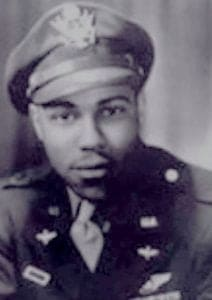Tuskegee Airman Earl Roscoe Lane was born in the rural all-Black town of Red Bird, Oklahoma, on July 22, 1920 to Levi and Christine Lane. In 1930, when he was 10, his family moved to Wickliffe, Ohio. His younger sisters were Barbara Lane Martin and Lizzie Mae Lane Smith.
Lane attended Wilberforce University, an HBCU in Wilberforce, Ohio. Afterward, he enlisted in the racially-segregated United States Army Air Force and was assigned to the Tuskegee Army Flight School at the Tuskegee Army Air Base near the campus of Tuskegee Institute (now Tuskegee University). Lane completed his training in class 44-D-SE on April 15, 1944, and was commissioned as a Second Lieutenant. Lane had further training with BT-13, AT-6, and P-40 aircraft bombers but began serving as a fighter pilot in the 100th Fighter Squadron, 332nd Fighter Group, 15th Air Force, also called the “Red Tail Angels.”
Later in 1944 Lane was assigned to the 99th Fighter Squadron that flew heavy bomber escort missions over Nazi-occupied Europe. Rising in rank to First Lieutenant, he and fellow pilots Charles Brantley and Roscoe Brown were part of the 99th which deployed to North Africa and then Italy.
On March 24, 1945, Lane and pilots Brantley and Brown, flying P-51 Mustangs, shot down three German Messerschmitt Me 262 jets, some of the most advanced light bomber jets in the German Luftwaffe, in an air fight over Berlin, Germany. The downing of the jets came during the most extended escort mission ever flown by the squadron, a 1600-mile round trip from a base in Italy to the Daimler-Benz tank works in Berlin. Mercedes-Benz built tanks and numerous other vehicles for Nazi Germany’s war effort.
During an intense aerial dogfight on April 12, 1945, eight P-51 Mustang pilots with the 332nd, shot down German aircraft. Lane, one of the eight pilots, scored a solo victory in his P-51 against another Me 262 jet. First Lieutenant Lane received numerous awards for his World War II military service including a Distinguished Flying Cross, a Legion of Merit, 744 Air Medals, a Purple Heart, a Bronze Star, and a Red Star of Yugoslavia.
Over the course of World War II, the 332nd Fighter Group, led by Colonel Benjamin O. Davis, commander of the Tuskegee Airmen, flew 15,533 combat sorties on 1,578 missions, and shot down 112 enemy aircraft in flight, earning it a Distinguished Unit Citation.
After the war ended, Earl Lane continued his studies at Adelbert College (now Case Western Reserve University) in Cleveland, Ohio, and earned a Bachelor of Law from John Marshall Law School in Chicago, Illinois. In 1948, Lane married Dorothy Chaffin, and they parented a daughter, Leslie Karen Lane Epps.
First Lieutenant Earl Roscoe Lane, one of the most noted African American aviators among the Tuskegee Airmen, died on June 27, 1990, in Cleveland, Ohio. He was 69.
Do you find this information helpful? A small donation would help us keep this available to all. Forego a bottle of soda and donate its cost to us for the information you just learned, and feel good about helping to make it available to everyone.
BlackPast.org is a 501(c)(3) non-profit and our EIN is 26-1625373. Your donation is fully tax-deductible.
Dan Maxson, https://lakehistorycenter.org/wp-content/uploads/2023/08/LCHS-blog-August-2023-Earl-Lane-Tuskegee-Airman.pdf; “Earl Roscoe Lane,” cafriseabove.org;
Robert F. Dorr, “Tuskegee Airmen vs. Me-262s: African-American fighter pilots shot down three German jets on one mission,” https://www.defensemedianetwork.com/stories/tuskegee-airmen-vs-me-262s/.
Your support is crucial to our mission.
Donate today to help us advance Black history education and foster a more inclusive understanding of our shared cultural heritage.

